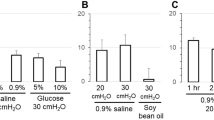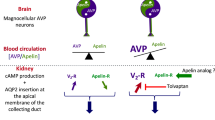Abstract
Considerable evidence supports the hypothesis that renal sodium excretion is partly regulated by a humoral agent released or activated by extracellular fluid volume (ECFY) expansion1, including the demonstration of biological activities in extracts of plasma and urine which support the natriuretic hormone (NH) hypothesis2–4. NH is a low molecular weight peptide formed from a precursor in plasma5, which inhibits sodium transport (anti-natriferic activity) in isolated toad bladder, an analogue of the distal renal tubule and collecting duct. Other evidence indicates that NH can inhibit renal (Na++ K+) ATPase6, which suggests that it might be an endogenous digitalis-like substance. Although an immunoreactive ouabain-like substance has been demonstrated in amphibian plasma7, none has been reported in mammals. To identify an endogenous digitalis-like substance, we used an approach suggested by the work of Spector and his collaborators, who demonstrated that biological substances which bind to the same receptors as drugs, such as endogenous opioids8 and benzodiazepines9, may compete with antibodies specific for the drugs. Hough and Edwardson10 showed that antibodies to thaumatin, a sweet-tasting plant protein, also bind non-protein sweet substances in a linearly related fashion to the sweetness of the compound, suggesting that the antibody binding site may be similar to the sweet taste receptor. Based on these observations, we postulated that if NH were an endogenous digitalis-like substance, it might bind to antibodies specific for digitalis glycosides. We report here the preliminary isolation of a substance in plasma of dogs which competes with digoxin for two specific digoxin antibodies and is an inhibitor of (Na+ + K+) ATPase activity. Increased amounts of this factor are found in plasma of volume-expanded dogs, suggesting it is the putative NH.
This is a preview of subscription content, access via your institution
Access options
Subscribe to this journal
Receive 51 print issues and online access
$199.00 per year
only $3.90 per issue
Buy this article
- Purchase on Springer Link
- Instant access to full article PDF
Prices may be subject to local taxes which are calculated during checkout
Similar content being viewed by others
References
de Wardener, H. C. Clin. Sci. molec. Med. 53, 1–8 (1977).
Buckalew, V. M. Jr, Martinez, F. J. & Greene, W. E. J. clin. Invest. 49, 926–935 (1970).
Clarkson, E. M., Raw, S. M. & de Wardener, H. E. Kidney Int. 10, 381–394 (1976).
Favre, H., Hwang, K. H., Schmidt, W., Bricker, N. & Bourgoignie, J. J. J. clin. Invest. 56, 1302–1311 (1975).
Gruber, K. A. & Buckalew, V. M. Jr Proc. Soc. exp. Biol. Med. 159, 463–467 (1978).
Hillyard, S. D., Lu, E. & Gonick, H. Circulation Res. 38, 250–255 (1976).
Flier, J. S., Marotos-Flier, E., Pallotta, J. A. & McIsaac, D. Nature 279, 341–343 (1979).
Ginzler, A., Levy, A. & Spector, S. Proc. natn. Acad. Sci. U.S.A. 73, 2132–2136 (1976).
Asano, T. & Spector, S. Proc. natn. Acad. Sci. U.S.A. 76, 977–979 (1979).
Hough, C. A. M. & Edwardson, J. A. Nature 271, 381–383 (1978).
Radhakrishnan, A. N., Stein, S., Licht, A., Gruber, K. A. & Undenfriend, S. J. Chromatogr. 132, 552–555 (1977).
Bohlen, P., Stein, S., Stone, J. & Undenfriend, S. Analyt. Biochem. 61, 438–445 (1975).
Burnett, G. H. & Conklin, R. L. J. Lab. clin. Invest. 78, 779–784 (1971).
Raghaven, S. R. V. & Gonick, H. Proc. Soc. exp. Biol. Med. 164, 101–104 (1980).
Eibl, H. & Lands, W. E. M. Analyt. Biochem. 30, 51–57 (1969).
Ahmed, K. & Williams-Ashman, H. G. Biochem. J. 113, 829–836 (1969).
Cantley, L. C. Jr et al. J. biol. Chem. 252, 7421–7423 (1977).
Flier, J. S. Nature 275, 285–286 (1978).
Lowenstein, J. M. Circulation 31, 228–233 (1965).
Lowenstein, J. M. & Corrill, E. M. J. Lab. clin. Med. 67, 1048–1052 (1966).
Gibson, T. P. & Nelson, H. A. J. clin. Res. 64, 665A (1979).
Gruber, K. A., Whitaker, J. M., Plunkett, W. C. & Buckalew, V. M. Jr Proc. Am. Soc. Nephrology, Abstr. 47A (1979).
Author information
Authors and Affiliations
Rights and permissions
About this article
Cite this article
Gruber, K., Whitaker, J. & Buckalew, V. Endogenous digitalis-like substance in plasma of volume-expanded dogs. Nature 287, 743–745 (1980). https://doi.org/10.1038/287743a0
Received:
Accepted:
Issue Date:
DOI: https://doi.org/10.1038/287743a0
This article is cited by
-
Regulation of the cardiac sodium pump
Cellular and Molecular Life Sciences (2013)
-
Endogenous digitalis: pathophysiologic roles and therapeutic applications
Nature Clinical Practice Nephrology (2008)
-
Diagnosis and management of cerebral salt wasting (CSW) in children: the role of atrial natriuretic peptide (ANP) and brain natriuretic peptide (BNP)
Child's Nervous System (2006)
-
Digoxin antibody decreases natriuresis and diuresis in cerebral hemorrhage
Intensive Care Medicine (2003)
-
Atrial natriuretic factor after transjugular intrahepatic portosystemic shunt in liver cirrhosis and ascites
European Surgery (1998)
Comments
By submitting a comment you agree to abide by our Terms and Community Guidelines. If you find something abusive or that does not comply with our terms or guidelines please flag it as inappropriate.



